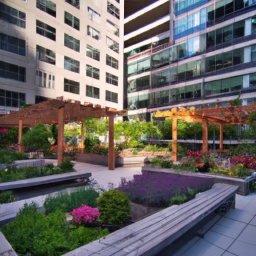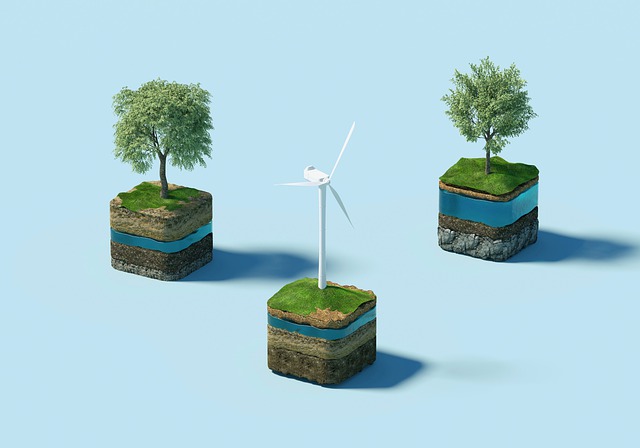In this article, you will learn about strategies to combat the urban heat island effect and promote cooler environments in cities. Urban heat island refers to the phenomenon of cities being significantly hotter than their surrounding rural areas, and it can have negative impacts on energy consumption, air pollution, human health, and the environment. By understanding the causes and effects of urban heat island, as well as implementing solutions such as light-colored concrete, green roofs, and urban planning strategies, we can work towards creating cooler and more sustainable urban environments.
One of the main causes of urban heat island is the materials and surfaces used in cities, such as low albedo materials and dark surfaces, which absorb and retain heat. Another contributing factor is the lack of vegetation, as trees and plants provide shade and evaporative cooling. By using light-colored concrete and white roofs, the amount of heat absorbed by buildings can be reduced, while planting trees and implementing green roofs can help to increase vegetation cover and provide natural cooling. Furthermore, urban planning strategies that prioritize the creation of parks, green spaces, and water features can promote cooler environments and mitigate the negative impacts of urban heat island.

Understanding Urban Heat Island
Urban heat island refers to the phenomenon of cities being significantly hotter than their surrounding rural areas. This can be attributed to various factors such as human activity, climate change, and the design of urban landscapes. In this article, we will explore the causes of urban heat island, its effects, and strategies to combat this issue in order to promote cooler environments.
Causes of Urban Heat Island
Low albedo materials
One of the major causes of urban heat island is the use of low albedo materials in urban areas. Albedo refers to the ability of a surface to reflect sunlight. Low albedo materials, such as dark asphalt and concrete, absorb more solar radiation, leading to higher surface temperatures.
Paved and impermeable surfaces
The extensive use of paved and impermeable surfaces in cities contributes to the heat island effect. These surfaces absorb heat during the day and release it slowly at night, resulting in higher nighttime temperatures. Additionally, the lack of vegetation and soil cover prevents natural cooling processes such as evapotranspiration.
Thermal mass of buildings
The thermal mass of buildings, particularly those made of materials with high heat storage capacity, can contribute to the urban heat island effect. These materials, such as concrete and brick, can absorb and retain heat, releasing it back into the environment over an extended period.
Dark surfaces
Dark surfaces, such as dark-colored roofs and roads, absorb more solar radiation and, as a result, increase surface temperatures in urban areas. These surfaces contribute to the overall heat island effect and can significantly impact the local microclimate.
Lack of vegetation
The lack of vegetation in urban areas is another major contributor to the urban heat island effect. Urbanization often involves the removal of trees and vegetation, which provide shade and cooling through evapotranspiration. This loss of greenery reduces the natural cooling capacity of the city.
Climate change
Climate change plays a role in exacerbating the urban heat island effect. Rising global temperatures increase the baseline temperature in both urban and rural areas. However, due to the additional heat generated by human activities and the lack of cooling mechanisms in cities, urban areas experience much higher temperatures than their surrounding rural areas.
Increased use of air conditioners
The increased use of air conditioners in urban areas contributes to the urban heat island effect. While air conditioning provides immediate relief from the heat, it releases waste heat into the environment, further contributing to higher temperatures in cities. This creates a vicious cycle where more energy is consumed to cool buildings, leading to increased energy consumption and greenhouse gas emissions.
Urban canopy
The urban canopy, which refers to the coverage of vegetation and trees in urban areas, plays a significant role in mitigating the urban heat island effect. A dense canopy can provide shade, reduce surface temperatures, and enhance evapotranspiration, which helps cool the surrounding environment.
Wind blocking
Buildings and infrastructure in urban areas can obstruct natural wind flow, leading to stagnant air and reduced ventilation. This lack of airflow contributes to higher temperatures in cities, as there is less natural cooling through wind movement.
Air pollutants
Air pollutants, such as particulate matter and smog, can exacerbate the urban heat island effect. These pollutants absorb and retain heat, increasing temperatures in cities. Additionally, air pollution can reduce the amount of incoming solar radiation, further impacting the energy balance and exacerbating the heat island effect.
Human activity
Finally, human activity itself contributes to the urban heat island effect. Activities such as industrial processes, transportation, and energy consumption release heat, further adding to the overall heat load in cities. The concentration of human activity in urban areas amplifies the impact of these heat-generating activities.

Effects of Urban Heat Island
The urban heat island effect has several significant effects on both the environment and human health. These effects include:
Increased energy consumption
Cities with a large urban heat island effect require more energy to cool buildings and maintain a comfortable indoor temperature. This increased energy consumption contributes to higher greenhouse gas emissions and strains on the power grid.
Elevated greenhouse gas emissions and air pollution
As mentioned earlier, the increased use of air conditioning and other cooling mechanisms in cities leads to higher energy consumption and greenhouse gas emissions. This contributes to climate change and worsens air quality.
Danger to aquatic systems
The urban heat island effect can also have detrimental effects on aquatic systems, such as rivers and lakes, within and around cities. Higher temperatures can lead to increased water evaporation, reduced water availability, and negative impacts on aquatic ecosystems.
Discomfort and danger to human health
Higher temperatures in urban areas can pose significant discomfort and health risks to residents. Heat-related illnesses such as heatstroke and heat exhaustion are more prevalent in cities with a strong urban heat island effect. Vulnerable populations, such as the elderly and those with pre-existing health conditions, are particularly at risk.
Impacts on weather and climate
The urban heat island effect can influence local weather patterns and climate. It can disrupt temperature gradients, airflow, and atmospheric stability, potentially leading to localized weather phenomena such as the formation of urban thunderstorms and increased rainfall intensity.
Impacts on animals
Urban heat islands can also have negative effects on wildlife and biodiversity. Animals that inhabit urban areas may struggle to cope with the increased heat, leading to decreased habitat suitability and potential population declines.
Strategies to Combat Urban Heat Island
To combat the urban heat island effect and promote cooler environments, various strategies can be implemented:
Use of light-colored concrete and white roofs
Increasing the albedo of urban surfaces can help reduce the urban heat island effect. Light-colored concrete and white roofs reflect more sunlight, reducing surface temperatures and overall heat absorption.
Green roofs and vegetation cover
Implementing green roofs and increasing vegetation coverage in cities can significantly mitigate the urban heat island effect. Green roofs provide insulation, reduce solar heat gain, and enhance evapotranspiration, helping to cool the surrounding environment.
Planting trees in cities
Urban areas can benefit from an increased urban tree canopy. Trees provide shade, enhance evapotranspiration, and reduce the direct impact of solar radiation. Proper selection and placement of trees can effectively reduce temperatures in cities.
Implementing urban planning strategies
Integrating urban planning strategies that prioritize the creation of cooler environments can help combat the urban heat island effect. This includes incorporating green spaces, prioritizing shade, and designing buildings and infrastructure with heat mitigation in mind.
Promoting cool roofs
Cool roofing materials and technologies can play a significant role in reducing the urban heat island effect. These roofs are designed to reflect solar radiation and emit heat, resulting in lower surface temperatures and reduced energy consumption for cooling purposes.
Cool pavements
Similar to cool roofs, cool pavements are designed to reflect more sunlight and reduce surface temperatures. Using materials with high solar reflectance for roads, sidewalks, and parking lots can help mitigate the urban heat island effect.
Increasing green spaces
Increasing the amount of green spaces, such as parks and gardens, can help reduce ambient temperatures in cities. These areas provide shade, enhance evapotranspiration, and promote a more comfortable and cooler urban environment.
Utilizing cool paint and coatings
The use of cool paint and coatings on buildings, roads, and other surfaces can help reduce the absorption of solar radiation and lower surface temperatures. These coatings are designed to reflect more sunlight and emit heat, contributing to a cooler urban environment.
Encouraging green infrastructure
Promoting the adoption of green infrastructure, such as rain gardens and permeable pavements, can help manage stormwater runoff, reduce heat absorption, and promote evapotranspiration.
Creating urban heat island mitigation programs
Government agencies, community organizations, and individuals can collaborate to develop urban heat island mitigation programs. These programs can raise awareness, provide resources and incentives, and encourage the implementation of strategies to combat the urban heat island effect.

Conclusion
The urban heat island effect poses significant challenges to both the environment and human health. Understanding the causes and effects of urban heat island is crucial in order to implement effective strategies to combat this issue.
Promoting cooler environments in cities requires a combination of approaches, including the use of light-colored concrete, green roofs, increased vegetation cover, urban planning strategies, and the promotion of cool roofs and pavements. These strategies can help reduce temperatures, energy consumption, and the negative impacts of urban heat islands on both the environment and human health. Collaboration between various stakeholders is essential to create and maintain cooler environments in our cities.



